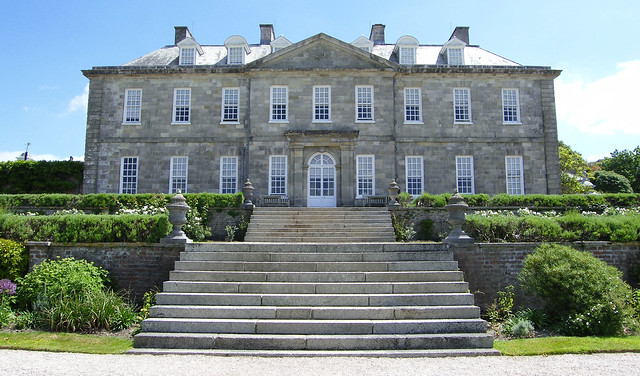Antony House
P3w1
North side
Antony House is a mansion on the Rame Peninsula, in the county of Cornwall in the UK. This classified as a cultural monument is a fine Grade I mansion is located northeast of the village of Antony, 3 km north- west of Torpoint and 9 km west of Plymouth.
History
Antony House was in 1432 the seat of the Carew family. 1711-1721 was William Carew build the present baroque mansion on site of an older house. The architect is unknown, the design is attributed to James Gibbs. 1839, the portico on the Hofsteite was grown, further modifications were removed during restoration after the Second World War. 1961 John Carew Pole gave the house and the garden to the National Trust. The house is still the family home Carew - Pole, home and garden, however, are to be visited from April to October from Tuesday to Thursday.
Plant
The mansion is located on a hill on a peninsula on the Hamoaze at the mouth of the River Lynher in the Tamar River.
The mansion is built of brick with two farm buildings, with which it is connected by colonnades, a main courtyard. The rectangular, two-storey manor house is also built of brick, but clad in Pentewan granite and has a slate roof.
Interior decoration
The magnificent interior dates back to a large extent from the building time. The hall, the library and the salon on the ground floor are paneled with Dutch oak. Facilities include Mamorkamine, numerous paintings, including several portraits of Reynolds, embroidery and other collections of the family.
Garden and park
The driveway of the house formal walled baroque garden with cut trees and avenues was remodeled in the 1790s, designed by Humphry Repton. The now 10 hectares in the garden falls on the north side with wide lawns and framed by oaks sightlines for Lynher River.
There is a formal garden with an octagonal pond, as a framed knot garden of yew hedges and flower beds as well as a wide, framed by yew battlements Rasenweg on the west side. In the garden are by General Reginald Pole Carew in the 19th century stone sculptures collected from northern India and a Burmese temple bell and modern sculptures, including one designed by William Pye bronze fountain, which takes up the form of a 10 m high, conical cut yew. In the garden there are numerous ornamental shrubs, exotic trees like a mighty cork oak on the south side and a black walnut on the north side of the mansion as well as a " National Collection " of over 600 daylily.
While the garden belongs to the National Trust, are the following, about 40 acres of Antony Woodlands owned by the Carew Pole Garden Trust. Having already Reginald Pole Carew was there Rhodendren create, designed by his son John Carew Pole the forest after the Second World War into a landscape park around. Situated in a sheltered valley forest of old stem and holm oaks and pines were added to Japanese maple trees, Himalayan birch trees, ginkgo trees and walnut trees. Colored accents ornamental shrubs such as magnolia and rhododendrons and camellias over 300 locations. Trails lead to lookouts over the Lynher River to a 1789 erbautem, fed with salt water from the Lynher bath house and modern sculptures, including a machined by Peter Randall - Page rock.
Antony House in film
Home and Garden served as a filming location for the Disney film version of Alice in Wonderland as well as for the Rosamunde Pilcher film in doubt for Love ( 2010).










